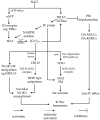Progress in Understanding the Physiological and Molecular Responses of Populus to Salt Stress
- PMID: 30875897
- PMCID: PMC6471404
- DOI: 10.3390/ijms20061312
Progress in Understanding the Physiological and Molecular Responses of Populus to Salt Stress
Abstract
Salt stress (SS) has become an important factor limiting afforestation programs. Because of their salt tolerance and fully sequenced genomes, poplars (Populus spp.) are used as model species to study SS mechanisms in trees. Here, we review recent insights into the physiological and molecular responses of Populus to SS, including ion homeostasis and signaling pathways, such as the salt overly sensitive (SOS) and reactive oxygen species (ROS) pathways. We summarize the genes that can be targeted for the genetic improvement of salt tolerance and propose future research areas.
Keywords: ROS; SOS; molecular mechanisms; poplars (Populus); salt tolerance.
Conflict of interest statement
The authors declare that they have no conflict of interest.
Figures

Similar articles
-
Populus trichocarpa EXPA6 Facilitates Radial and Longitudinal Transport of Na+ under Salt Stress.Int J Mol Sci. 2024 Aug 29;25(17):9354. doi: 10.3390/ijms25179354. Int J Mol Sci. 2024. PMID: 39273303 Free PMC article.
-
Overexpression of the PtSOS2 gene improves tolerance to salt stress in transgenic poplar plants.Plant Biotechnol J. 2015 Sep;13(7):962-73. doi: 10.1111/pbi.12335. Epub 2015 Jan 30. Plant Biotechnol J. 2015. PMID: 25641517
-
Poplar PdPTP1 Gene Negatively Regulates Salt Tolerance by Affecting Ion and ROS Homeostasis in Populus.Int J Mol Sci. 2020 Feb 5;21(3):1065. doi: 10.3390/ijms21031065. Int J Mol Sci. 2020. PMID: 32033494 Free PMC article.
-
On the salty side of life: molecular, physiological and anatomical adaptation and acclimation of trees to extreme habitats.Plant Cell Environ. 2015 Sep;38(9):1794-816. doi: 10.1111/pce.12440. Epub 2014 Nov 7. Plant Cell Environ. 2015. PMID: 25159181 Review.
-
Salinity tolerance of Populus.Plant Biol (Stuttg). 2010 Mar;12(2):317-33. doi: 10.1111/j.1438-8677.2009.00301.x. Plant Biol (Stuttg). 2010. PMID: 20398238 Review.
Cited by
-
Physiological and Molecular Analysis Reveals the Differences of Photosynthesis between Colored and Green Leaf Poplars.Int J Mol Sci. 2021 Aug 20;22(16):8982. doi: 10.3390/ijms22168982. Int J Mol Sci. 2021. PMID: 34445687 Free PMC article.
-
Defense mechanisms promoting tolerance to aggressive Phytophthora species in hybrid poplar.Front Plant Sci. 2022 Oct 13;13:1018272. doi: 10.3389/fpls.2022.1018272. eCollection 2022. Front Plant Sci. 2022. PMID: 36325556 Free PMC article.
-
In vitro selection of drought-tolerant white poplar clones based on antioxidant activities and osmoprotectant content.Front Plant Sci. 2023 Nov 16;14:1280794. doi: 10.3389/fpls.2023.1280794. eCollection 2023. Front Plant Sci. 2023. PMID: 38046609 Free PMC article.
-
A DEAD box helicase Psp68 positively regulates salt stress responses in marker-free transgenic rice plants.Transgenic Res. 2023 Aug;32(4):293-304. doi: 10.1007/s11248-023-00353-x. Epub 2023 May 29. Transgenic Res. 2023. PMID: 37247124
-
Salinity Tolerance in Plants: Trends and Perspectives.Int J Mol Sci. 2019 May 15;20(10):2408. doi: 10.3390/ijms20102408. Int J Mol Sci. 2019. PMID: 31096626 Free PMC article.
References
-
- Wu Z.Y., Raven P.H., editors. Flora of China. Volume 4. Beijing: Science Press; Beijing, China: Missouri Botanical Garden Press; St. Louis, MO, USA: 1999. pp. 139–162.
-
- Sixto H. Response to sodium chloride in different species and clones of genus Populus L. Forestry. 2005;78:93–104. doi: 10.1093/forestry/cpi009. - DOI
-
- Bradshaw H.D., Ceulemans R., Davis J., Stettler R. Emerging Model Systems in Plant Biology: Poplar (Populus) as A Model Forest Tree. J. Plant Growth Regul. 2000;19:306–313. doi: 10.1007/s003440000030. - DOI
Publication types
MeSH terms
Substances
Grants and funding
LinkOut - more resources
Full Text Sources
Miscellaneous

